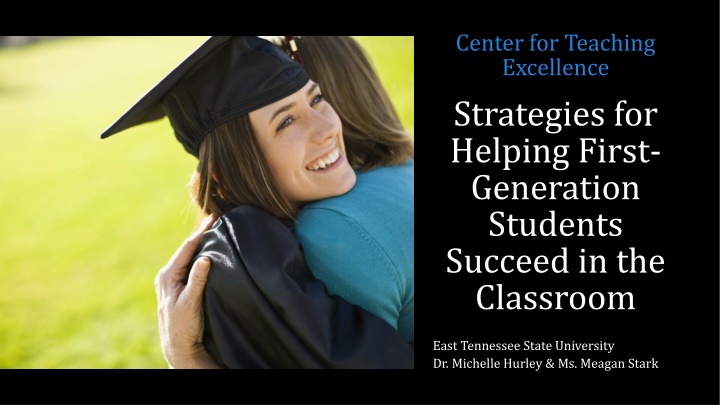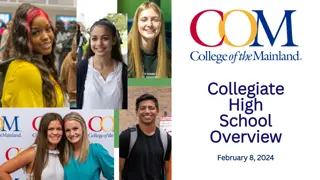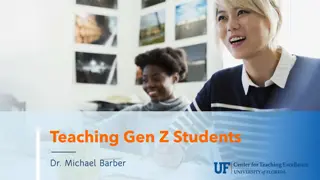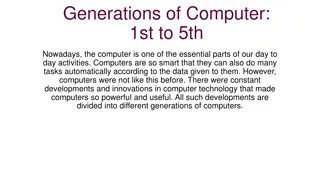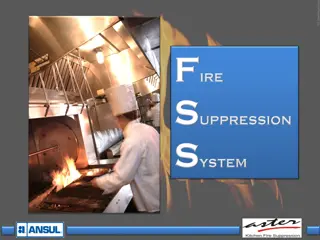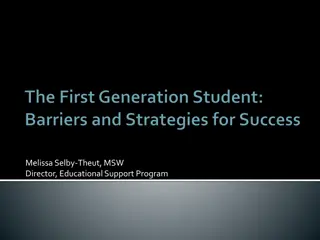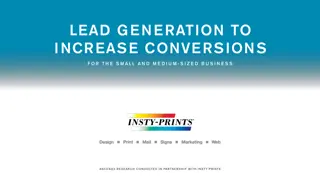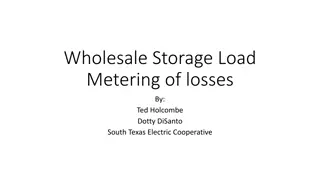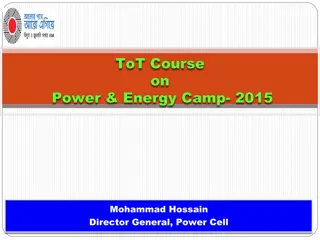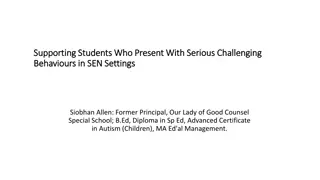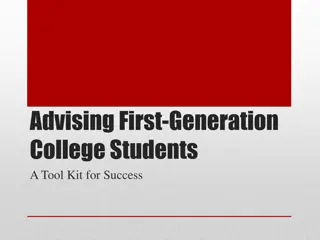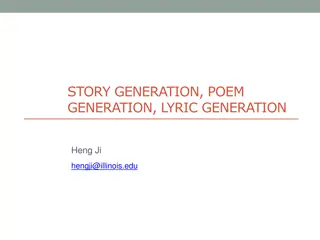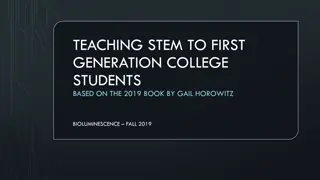Supporting First-Generation Students: Strategies and Challenges
Strategies and challenges in assisting first-generation students at East Tennessee State University are explored in this presentation. Topics include identifying FG students, interventions to help them succeed, barriers they face, and university challenges they encounter. The content sheds light on the experiences and struggles of FG students, emphasizing the need for understanding and support to bridge educational disparities.
Download Presentation

Please find below an Image/Link to download the presentation.
The content on the website is provided AS IS for your information and personal use only. It may not be sold, licensed, or shared on other websites without obtaining consent from the author.If you encounter any issues during the download, it is possible that the publisher has removed the file from their server.
You are allowed to download the files provided on this website for personal or commercial use, subject to the condition that they are used lawfully. All files are the property of their respective owners.
The content on the website is provided AS IS for your information and personal use only. It may not be sold, licensed, or shared on other websites without obtaining consent from the author.
E N D
Presentation Transcript
Center for Teaching Excellence Strategies for Helping First- Generation Students Succeed in the Classroom East Tennessee State University Dr. Michelle Hurley & Ms. Meagan Stark
Overview of Presentation Who are first-generation (FG) students? Barriers and challenges for FG students Interventions to assist FG students Discussion Questions
What does it mean to be first? Overcoming feelings of inadequacy and insecurity is one of the first and hardest obstacles that I have faced. I was in a foreign place where everyone seemed to have an advantage but me. I was lucky in that I had professors from similar backgrounds. If not for this, I would not be where I am today. My first few years [of college] were filled with depression, stress and feelings of I should have known this and why can I not grasp this class? Now as a senior who is graduating with honors, I feel relieved. However, I still feel underprepared at times Do not underestimate me. I am trying my hardest. But don t overestimate what I know because I might not know what you think is given knowledge for a college student. Please understand the gaps in our knowledge. Allowing students to know that is okay not to know everything helps. My experience as a [FG] student has been like a mouse navigating an academic maze where I am noticing that the other mice are more efficient than I am. I don t understand what the difference is between us, which causes me self-doubt and anxiety. Getting my education is my priority but I can t get my education unless I work. Please understand my struggle to balance my life.
Who are our first-generation students? Roughly 32% of students in the U.S. (Georgetown University Center on Education, 2012) First-generation students graduate at a significantly lower rate (26% versus 68% w/in 8 years) even when demographics, motivation, preparation, academic progress, grade point average and income are accounted for. (Murphy & Hicks, 2006). Disproportionately likely to be female, African-American, Hispanic, low-income, have dependent children. (Georgetown University Center on Education, 2012) Enroll in and graduate from college at significantly lower rates than second & third generation peers. (Georgetown University Center on Education, 2012) At ETSU approximately 35% (4000) of students are first- generation. (Office of Institutional Effectiveness, Fall 2017)
Barriers and University Challenges (Selby-Theut; Attewell, Heil& Reisel) Academic Barriers Financial Barriers Report lower educational aspirations Uninformed about financial aid processes, etc. More likely to enter college academically unprepared More likely to have additional financial obligations Reading comprehension and critical thinking do not improve at as high a rate as peers Have fewer resources to pay for college Earn lower GPA s and take fewer hours Avoid math, science and humanities majors Nature of and time allotted to work/study differ from that of second- generation peers Have a less positive attitude about literacy (reading and writing activities) Have trouble identifying major, finding internships or building their resume More likely to meet employment obligations than academic obligations
Barriers and University Challenges (Collier & Morgan; Selby-Theut; Lowery-Hart & Pacheco; Attewell, Heil, & Reisel) Social Barriers Cultural Barriers More likely to live off campus Less likely to identify college as necessary to achieving goals. Less likely to participate in on-campus organizations/events Parents lack college knowledge Only 50% report that their parents are supportive of their decision to attend college Identify their closest friends as someone other than college students Live simultaneously in two vastly different worlds while being fully accepted in neither. Report higher rates of isolation and discrimination Can t find their place Often lack insight about WHY they are struggling Worry that their experiences won t be validated or appreciated Perceive faculty as distant or unconcerned with them as individuals- intimidated Segregating maintains the familiar familial identities and keeps them safe
FG Combined with Appalachian Culture (Collier & Morgan; Lowery-Hart & Pacheco; Hlinka, Mobelini& Giltner; Hlinka) Factors that affect retention: A) Community s & family s values of education provide the initial PUSH to attend and complete college Better paying jobs Less physical labor B) Students are challenged with possessing the cultural capital that enables them to overcome the PULL of family obligations Sticking together Cannot always tell when academics trump family College student versus own identity tied to family Phony . Honoring own culture by rejecting college culture. Divided consciouseness. C) Students struggle to collect the academic capital to master college-level coursework The transition from concrete (memorization) to abstract orders of cognitive development
Seven Principles for Good Practice in Undergraduate Education (Padgett, Johnson & Pascaralla) 1) Encouraging contact between student and faculty * Paradox for FG students 2) Encouraging cooperation among students ** Very helpful 3) Encourage active learning 4) Provide prompt feedback 5) Emphasize time on task 6) Communicate high expectations 7) Respect diverse talents and ways of learning
1) Encouraging Contact Between Faculty and Student Explain office hours Work on being approachable Model courtesy Initiate contact/offer incentives for contact Humanize Identify as FG if that applies Limit academic jargon Make a concerted effort to learn something personal about the student Engage with students outside the classroom sports events, conferences, etc.
2) Encouraging Cooperation Among Students Encourage participation in tutoring. ( I was taught to do it on my own and not take help ). Assistance v. Resistance Develop and facilitate group study Pair FG student with a continuing student (discretely) Develop low-stakes group work/assignments Shrink the campus into a more manageable community Monitor language that is used in the classroom so that in-groups and out- groups are not created in terms of prior academic experiences. Incorporate self-assessment and peer review
A Fish In Water Vincent Tinto s (1975) Integration Theory: Students must first feel socially integrated, as though they belong or fit in the college setting, before being able to focus on academic integration
3) Encourage Active Learning Design assignments that emphasize practical application Teach from a learning outcomes framework what students will know, will be able to do Tap into students prior experiences and help them learn how to apply it to new content Help students understand how your class fits into their major/minor and into their professional preparation
4) Provide Prompt Feedback Provide examples of strong and weak work Offer constructive feedback so that formative evaluation can take place. Don t forget to highlight student strengths. Help students understand what it means to evaluate and critique ideas. Some FG students may come from backgrounds that punish vulnerabilities and views criticism as a personal attack. Some FG students may not be familiar with the academic process that is part of college culture. Normalize the process. Help students to identify resources where they can receive help. Offer incentives for help-seeking behaviors
5) Emphasize Time on Task Students feel that the time they have available for schoolwork should determine priorities (rather than what amount of time it would actually take to master the material). School should fit with other responsibilities not necessarily be the priority. FG students tend to overcommit but have fewer resources. Help students learn the balance between home and school. Time management skills should be emphasized. Proactive advising is helpful. Helping family alleviates some of the family achievement guilt felt by many FG students
6) Communicate High Expectations Communicate high expectations in a supportive way Be intentional. Explain your teaching approach and instructional strategies. Provide guidelines and rubrics on how students will be evaluated. Use a detailed syllabus with bullet points and bold font to emphasize important points. Be specific about how to take notes. Faculty think that they already do this. Don t just hand out go over. Understanding the implied meaning is not always a given. Write the paper for example. Be explicit. Check assignments for clarity. Style guides. FG students want faculty to be more explicit on how to take notes, assignment descriptions and specifics about tests. FG students tend to rely almost exclusively on information that they hear and observe in class from the professor.
7) Respect Diverse Talents and Ways of Learning Bringing FG cultural wealth into classroom. Use intergroup dialogue (supportive, safe and identity-safe) to explore how significant social differences such as race, ethnicity, gender, social class, etc. can shape their own and others experiences and opportunities in college and life. Have a conversation about what it means to be a good son or daughter and a good student at the same time- can t always be do what you re told - Storytelling about success is a powerful tool My aunt s boyfriend s sister s dog had to be put down.
Diverse Talents Cont. Help students feel valued and cared for (mimicking the familial experience to some extent). Coddling versus cutting the apron strings finding the balance. Highlighting and reframing deficits as strengths. Build bridges between their home and validate their presence at the academy. ( Educate students and families on the realities of earning an education and setting priorities) Familiarize students with what resources are available.
TRIO RESOURCES AT ETSU Student Support Services McNair Program Tutoring Undergraduate retention Graduate School Counseling Research skill development Career Counseling Graduate school preparation Personal Counseling Faculty mentors WILL BE LOCATED IN LUCILLE CLEMENT DURING CULP RENO LOCATED IN THE CAMPUS CENTER BUILDING
Discussion Questions How can you be flexible in the classroom and still maintain some sense of structure? How do you find the time to do all this while still teaching your content?
References Billson, J., & Brooks, T. (1981). In search of the silken purse: Factors in attrition among first- generation students. Presented to the Annual Meeting of the Association of American Colleges. Denver, CO. Engle, J, Bermeo, A., & O Brien, C. (2006). Straight from the source: what works for first-generation college students. Pell Institute for the Study of Opportunity in Higher Education. Washington, DC. Hlinka, K.R. (2017). Tailoring retention theories to meet the needs of rural Appalachian community college students. Community College Review, 45 (2), 144-164. Murphy, C., & Hicks, T. (2006). Academic characteristics among first-generation and non-first generation college students. College Quarterly, 9. Terenzini, P., Springer, L., Yaeger, P., Pascarella, E., & Nora, A. (1995). First-generation college students: Characteristics, experiences, and cognitive development. Association for Institutional Research. Boston, MA. First-Generation Students in Postsecondary Education: A Look at Their College Transcripts. (2005). National Center for Education Statistics Descriptive Analysis Report.
References cont. Stephens, N.M., Hamedani, M.G., Destin, M. (2014). Closing the social-class achievement gap: A difference education intervention improves first-generation students academic performance and all students college transition. Psychological Science, 25, (4), 943-953. Padgett, R.D., Johnson, M.P., Pascarella, E.T. (2012). First-generation undergraduate students and impact of the first year of college: Additional evidence. Journal of College Student Development, 53 (2), 243-266. Promoting instructional success for first-generation college students (n.d.). Center for Educational Effectiveness , UC Davis. Lohman, L. (2015). Twenty-two tips for teaching first-generation college students at CSUF. Collier, P.J. & Morgan, D.L. (2008). Is that paper really due today? : Differences in first-generation and traditional college students understanding of faculty expectations. Higher Education 55, 425-446. Lowery-Hart, R. & Pacheco, G. (2011). Understanding the first-generation student experience in higher education through a relational dialectic perspective. New Directions for Teaching and Learning, 127, (55- 68). Selby-Theut, M. (n.d.). The first generation student: Barriers and strategies for success. Retrieved 1/23/2018.
References cont. Attewell, P., Heil, S. & Reisel, L. (2011). Competing explanations of undergraduate noncompletion. American Educational Research Journal, 48 (3), 536-559. Hlinka, K.R., Mobelini, D.C. & Giltner, T. (2015). Tensions impacting student success in a rural community college. Journal of Research in Rural Education, 30 (5), 1-16. Stephens, N.M., Fryberg, S. A., Markus, H.R., Johnson, C.S. & Covarrubias, R. (2012). Unseen disadvantage: How American universities focus on independence undermines the academic performance of first-generation college students. Journal of Personality and Social Psychology, 102 (6), 1178-1197. Phillips, L. T., Stephens, N.M. & Townsend, S.S.M. (2016). Access is not enough: Cultural mismatch persists to limit first-generation students opportunities for achievement through college. [Scholarly project]. J.L. Kellogg School of Management at Northwestern University. Retrieved 03/30/2018. Tinto, V. (1975). Dropout from higher education: A theoretical synthesis of recent research. Review of Educational Research 45, (1), 89-125.
